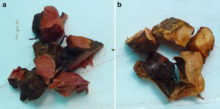| Smilax glabra | |
|---|---|

| |
| Scientific classification | |
| Kingdom: | Plantae |
| Clade: | Tracheophytes |
| Clade: | Angiosperms |
| Clade: | Monocots |
| Order: | Liliales |
| Family: | Smilacaceae |
| Genus: | Smilax |
| Species: | S. glabra |
| Binomial name | |
| Smilax glabra Roxb. | |
| Synonyms | |
| |
Smilax glabra, sarsaparilla, is a plant species in the genus Smilax. It is native to China, the Himalayas, and Indochina.
S. glabra is a traditional medicine in Chinese herbology, whence it is also known as tufuling (土茯苓) or chinaroot, china-root, and china root (a name it shares with the related S. china). Chinaroot is a key ingredient in the Chinese medical dessert guilinggao, which uses its ability to set certain kinds of jelly.
Chemical composition
Dihydro-flavonol glycosides (astilbin, neoastilbin, isoastilbin, neoisoastilbin, (2R, 3R)-taxifolin-3'-O-beta-D-pyranoglucoside) have been identified in the rhizome of Smilax glabra as well as smitilbin, a flavanonol rhamnoside. Smiglabrone A and Smiglabrone B are phenylpropanoid-substituted epicatechins that have also been isolated from the root.
Sarsasapogenin, a steroidal sapogenin, can also be found in S. glabra.
Use in traditional Chinese medicine
The root of S. glabra is used in traditional Chinese medicine (TCM) to treat dysentery, joint pain and colds. S. glabra is grown in Southern China. The rhizome of the plant is collected and dried during all seasons for herbal use. The dried root is mixed with water and taken orally. It is believed to restore balance in the body in response to yin disease by removing dampness and toxicity.
References
- ^ Kew World Checklist of Selected Plant Families
- Sarsaparilla on rain-tree.com
- Smitinand, T. & Larsen, K. (eds.) (1975). Flora of Thailand 2: 1-484. The Forest Herbarium, National Park, Wildlife and Plant Conservation Department, Bangkok.
- Leroy, J.-F. (ed.) (1983). Flore du Cambodge du Laos et du Viêt-Nam 20: 1-175. Muséum National d'Histoire Naturelle, Paris.
- Ahmed, Z.U. (ed.) (2008). Encyclopedia of Flora and Fauna of Bangladesh 12: 1-505. Asiatic Society of Bangladesh.
- Leti, M., Hul, S., Fouché, J.-G., Cheng, S.K. & David, B. (2013). Flore photographique du Cambodge: 1-589. Éditions Privat, Toulouse.
- Yuan JZ, Dou DQ, Chen YJ, et al. (September 2004). "". Zhongguo Zhong Yao Za Zhi (in Chinese). 29 (9): 867–70. PMID 15575206.
- A Flavonol Glycoside from Smilax glabra, Ting Chen, Jian Xin Li, Yu Cai, Qiang Xu, Chinese Chemical Letters, Vol. 13, No 6, 2002, pages 537-538
- ^ Xu, Shuo; Shang, Ming-Ying; Liu, Guang-Xue; Xu, Feng; Wang, Xuan; Shou, Cheng-Chao; Cai, Shao-Qing (May 2013). "Chemical Constituents from the Rhizomes of Smilax glabra and Their Antimicrobial Activity". Molecules. 18 (5): 5265–5287. doi:10.3390/molecules18055265. PMC 6270451. PMID 23698042.
- Gu, Wan-Yi; Li, Na; Leung, Elaine; Zhou, Hua; Luo, Guo-An; Liu, Liang; Wu, Jian-Lin (2015-03-02). "Metabolites Software-Assisted Flavonoid Hunting in Plants Using Ultra-High Performance Liquid Chromatography-Quadrupole-Time of Flight Mass Spectrometry". Molecules. 20 (3): 3955–3971. doi:10.3390/molecules20033955. ISSN 1420-3049. PMC 6272731. PMID 25738538.
- Tian, Li-Wen; Zhang, Zhen; Long, Hai-Lan; Zhang, Ying-Jun (2017). "Steroidal Saponins from the Genus Smilax and Their Biological Activities". Natural Products and Bioprospecting. 7 (4): 283–298. doi:10.1007/s13659-017-0139-5. ISSN 2192-2195. PMC 5507813. PMID 28646341.
- Wu, Jing-Nuan (2005). An Illustrated Chinese Materia Medica. Oxford University Press. ISBN 9780195140170.
External links
This Liliales article is a stub. You can help Misplaced Pages by expanding it. |